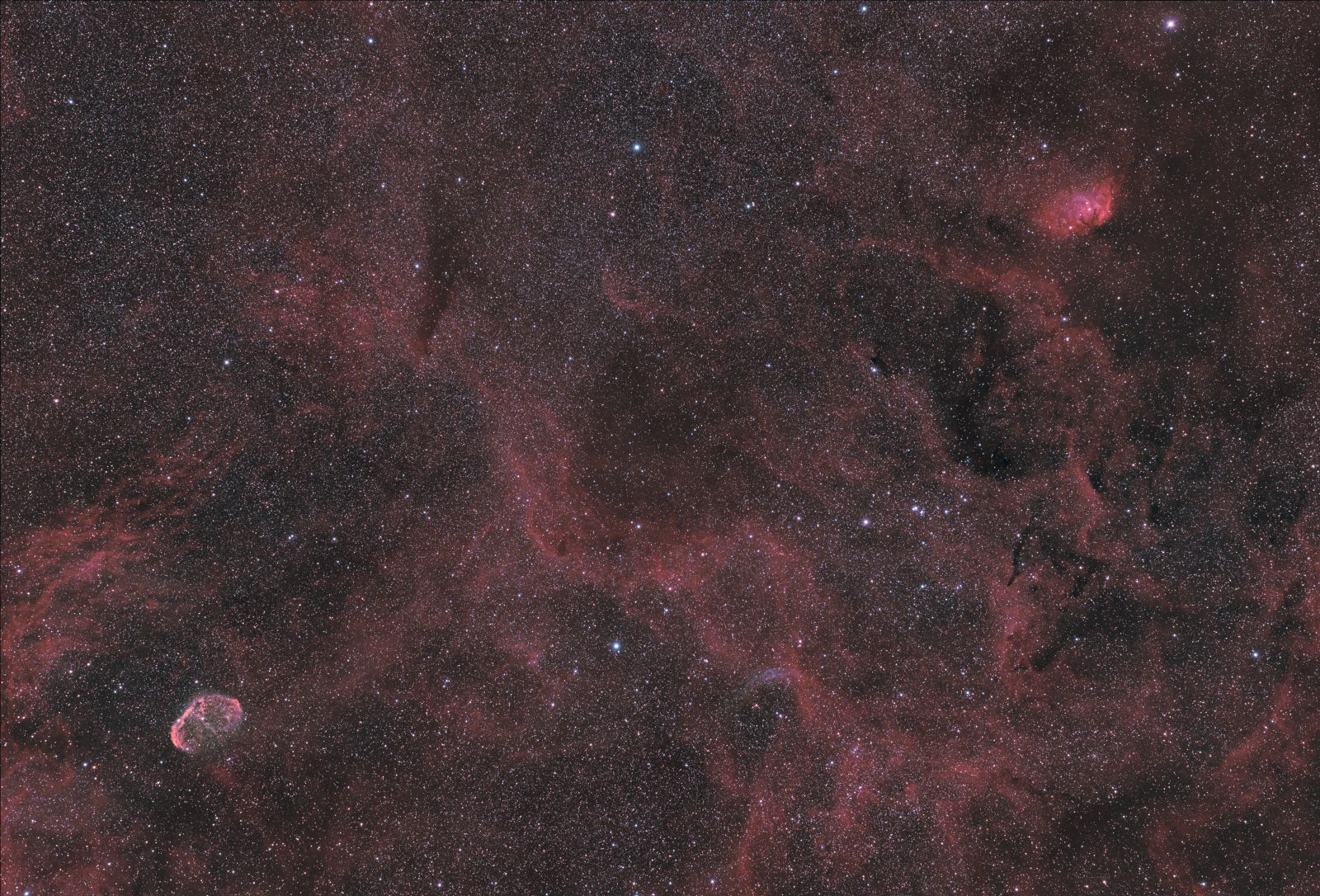Crescent Nebula to Tulip Nebula
 Click image for full size version
Click image for full size version
October 6, 2019
This image shows a very wide field, stretching from the Crescent Nebula (NGC 6888) at lower left to the Tulip Nebula (Sh2-101) at upper right. In between are twisted braids of glowing gas, dark nebulae made of the Milky Way’s dust, and millions of stars of different hues. This patch of nebulosity of nebulosity lies about 5,000 – 5,800 light years away. It is located in the thick of the summer Milky Way (for the northern hemisphere), right in the centre of Cygnus the Swan. That’s why the image is overflowing with stars. I am pretty sure the pink and teal arc near bottom centre is Cederblad 177, but I wasn’t able to verify it.
Tekkies:
Takahashi FSQ-106 ED IV @ f/3.6, QHY367C one-shot colour camera, and Optolong L-eNhance narrowband filter, Paramount MX, unguided. Acquisition, and focusing with TheSkyX. Focus with Optec DirectSync focus motor and controller. Automation with CCDCommander. Equipment control with PrimaLuce Labs Eagle 3 Pro computer. All pre-processing and processing in PixInsight. Acquired from my SkyShed in Guelph. Waning crescent Moon, average to above average transparency and fair to average seeing. Data acquired August 28 – September 5, 2019.
86x10m with Optolong L-eNhance filter (Total = 14hr20m)
Image scale 2.6 arcsec per pixel
Data Reduction and Cleanup
Preprocessing: The BatchPreProcessing script was used to perform calibration, debayering, and registration of all frames. ImageIntegration followed by DrizzleIntegration with the CFA Drizzle option was used to make the master, which was then cropped.
Gradient Removal: Gradient removal was not necessary.
Channel Registration: To improve channel registration, the RGB colour channels were extracted and aligned with ImageIntegration, using 2D Surface Splines with Distortion Correction and the Green channel as the reference frame. The registered colour channels were recombined with RGBCombination.
Luminance Extraction: RGBWorkingSpace was applied to normalize the channels, and the Luminance was extracted for separate processing as described below.
Colour
Colour Balancing: The colour image was colour balanced with ColorCalibration.
Linear Noise Reduction: MultiscaleLinearTransform was used to reduce noise in the background areas, using an internal mask to protect bright structures. Layer settings for threshold and strength: Layer 1: 5.0 0.75 Layer 2: 3.0, 0.70 Layer 3: 2.0, 0.6 Layer 4: 1.0, 0.2.
Stretching: HistogramTransformation was applied to make a pleasing, bright image, with background set to an intensity of approximately 0.10.
Luminance
Linear Noise Reduction: MultiscaleLinearTransform was used to reduce noise in the background areas, using an internal mask to protect bright structures. Layer settings for threshold and strength: Layer 1: 3.0 0.9 Layer 2: 2.0, 0.75 Layer 3: 1.0, 0.6 Layer 4: 0.5, 0.2.
Stretching: HistogramTransformation was applied to make a pleasing, bright image, with background set to an intensity of approximately 0.10.
Recombining Luminance and RGB
LRGB Combination: The luminance image was applied to the RGB image using LRGBCombine with default settings.
Additional Processing
Nonlinear Noise Reduction: TGVDenoise was used in L*a*b* mode to reduce noise with a mask used to target the background areas and protect the stars (max. 1000 iterations and convergence selected for both lightness and chrominance).
Contrast Enhancement: LocalHistogramEqualization was applied (scale of 50 with strength 0.35) using a mask to protect stars and low-signal regions of the image.
Final Steps: Background, nebula and star brightness, contrast, hue and colour saturation were adjusted in several iterations using CurvesTransformation with masks as required. The image was rescaled to its original scale of 2.6″/pixel.






Excellent as usual Ron!